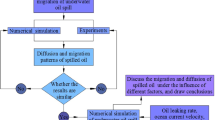Abstract
Pollution due to spilled oil presents serious natural environment issues. In order to take effective measures against such accidents, the knowledge of behavior of oil in such accidents is urgently required. Although its behavior both offshore and in the surfzone is important, this paper concentrates on the latter problem. A flow field of seawater and spilled oil above and under the beach is simulated numerically in this study. This research effort adopts the Cross model as a constitutive equation for spilled oil. Oil adhesion properties are taken into consideration through a friction type boundary condition prescribed on the surface of spilled oil. Flow equations for respective fluids and boundary conditions between them are unified into a single flow equation to construct a numerical model. The fictitious domain method plays an important role in the unification procedure. Computation becomes rather simple due to unification of equations.
Similar content being viewed by others
References
H.A. Barnes, J.F. Hutton and K. Walters, An Introduction to Rheology. Elsevier Science Publishers, 1989.
E.C. Bingham, Fluidity and Plasticity. McGraw-Hill, New York, 1922.
F. Collino, P. Joly and F. Millot, Fictitious domain method for unsteady problems. J. Comput. Phys.,138 (1997), 907–938.
M.M. Cross, Rheology of non-Newtonian fluids: a new flow equation for pseudo-plastic systems. J. Colloid Sci.,20 (1965), 417–437.
G. Duvaut and J.L. Lions, Inequalities in Mechanics and Physics. Springer-Verlag, 1976.
H. Fujita and H. Kawarada, Variational inequalities for the Stokes equation with the boundary conditions of friction type. GAKUTO International Series, Mathematical Sciences and Applications11, 1998, 15–33.
H. Fujita, H. Kawahara and H. Kawarada, Distribution theoretic approach to fictitious domain method for Neumann problems. East-West J. Numer. Math.,3, (1995), 111–126.
R. Glowinski, J.L. Lions and R. Tremolieres, Numerical Analysis of Variational Inequalities, North-Holland Publishing Company, 1981.
R. Glowinski, T.W. Pan, R.O. Wells Jr. and X.D. Zhou, Wavelet and finite element solutions for the Neumann problem using fictitious domains. J. Comput. Phys.,126 (1996), 40–51.
F.H. Harlow and J.E. Welch, Numerical calculation of time-dependent viscous incompressible flow of fluid with free surface. Phys. Fluids,8 (1965), 2182–2189.
E. Heikkola, Y. Kuznetsov, P. Neittaanmäki and J. Toivanen, Fictitious domain methods for the numerical solution of two-dimensional scattering problems. J. Comput. Phys.,145 (1998), 89–109.
C.W. Hirt and B.D. Nichols, Volume of fluid (VOF) method for the dynamics of free boundaries. J. Comput. Phys.,39 (1981), 201–225.
T. Kawamura and K. Kuwahara, Computation of high Reynolds number flow around a circular cylinder with surface roughness. AIAA Paper, 84-0340, 1984.
H. Kawarada, H. Fujita and H. Suito, Wave motion breaking upon the shore. GAKUTO International Series, Mathematical Sciences and Applications11, 1998, 145–159.
H. Kawarada and H. Suito, Numerical method for a free surface flow on the basis of the fictitious domain method. East-West J. Numer. Math.,5 (1997), 57–66.
J-G. Lee, C-J. Cheong, W. Nishijima, M. Okada and E. Baba, Effects of seawater flow on the soil structure in tidal flat. J. Society of Water Environment,22 (1999), 677–682.
M.S. Longuet-Higgins, Wave set-up, percolation and undertow in the surfzone. Proc. Royal Society London,A 390 (1983), 283–291.
A.W. Sisko, The flow of lubricating greases. Ind. Eng. Chem.,50 (1958), 1789–1792.
M. Sussman, P. Smereka and S. Osher, A level set approach for computing solutions to incompressible two-phase flow. J. Comput. Phys.,114 (1994), 146–159.
S-L. Zhang, GPBi-CG: Generalized product-type methods based on Bi-CG for solving nonsymmetric linear systems. SIAM J. Sci. Comput.,18 (1998), 537–551.
Author information
Authors and Affiliations
Corresponding author
Additional information
This work is partially supported by Showa Shell Sekiyu Foundation for Promotion of Environmental Research.
About this article
Cite this article
Suito, H., Kawarada, H. Numerical simulation of spilled oil by fictitious domain method. Japan J. Indust. Appl. Math. 21, 219 (2004). https://doi.org/10.1007/BF03167472
Received:
Revised:
DOI: https://doi.org/10.1007/BF03167472



